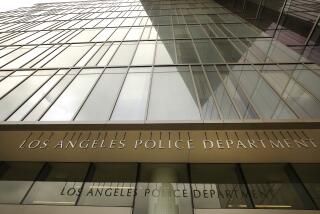To catch a profiling police officer
Racial profiling by police is notoriously difficult to prove. That’s not, as former Los Angeles Police Chief William J. Bratton used to insist, because it’s uniquely difficult to get inside an officer’s head and determine why he pulled over this suspect or that. Analyzing the intent behind offenses is actually fairly commonplace — it undergirds hate-crime prosecutions, many assaults (a murder, for instance, is distinguishable from manslaughter by the intent of the perpetrator) and even civil rights violations, which generally must be committed with the intent to deprive a person of a protected right. No, what makes racial profiling so hard to prove is that it’s usually most apparent in statistics, not individual acts.
An officer can almost always produce an explanation for why he or she pulled over a driver. A broken taillight, a failure to signal, speeding — all those are legitimate reasons to wave a driver to the curb. When it becomes obnoxious — and illegal — is when an officer sees those violations only when they are committed by people of a certain race. Long before “racial profiling” became the phrase of art, this vile habit was named for those victimized by it: “driving while black.”
Now, the Los Angeles Police Department, which once was widely suspected of engaging in racial profiling, has identified an officer it says is guilty of the offense. Tellingly, the allegations against Officer Patrick Smith — if true — include a clear sign of his intent, which was in part to deceive those who analyze statistics. According to sources in the department, Smith falsified reports to suggest that he was pulling over whites when in fact some of those he identified as white were Latino. Smith has been found guilty of nothing. Still, it is worth noting that doctoring official records would make his numbers look fine but also would suggest a need to cover up something, and could be evidence that the officer’s intent was improper. What may fool the statistics may prove the crime.
The advent of sophisticated, usually computerized, tracking has allowed police departments greater insight into the actions of officers — and, thus, clues about who may be indulging in racism — but better tools must be employed smartly. A traffic officer who stops only blacks or Latinos while working in West Los Angeles is probably missing something or covering up something; an officer working a night shift in South Los Angeles might well be fully justified in making such stops exclusively, because he might go an entire shift without seeing a single white driver. Smart analysis of that data can help officials sniff out trouble, but it won’t always be enough. Where they find deception, they may see all too clearly into an officer’s head.
More to Read
A cure for the common opinion
Get thought-provoking perspectives with our weekly newsletter.
You may occasionally receive promotional content from the Los Angeles Times.










